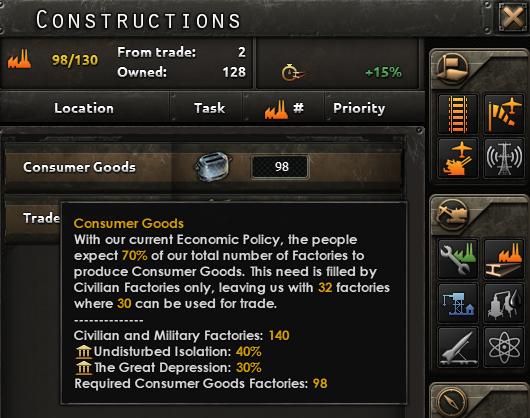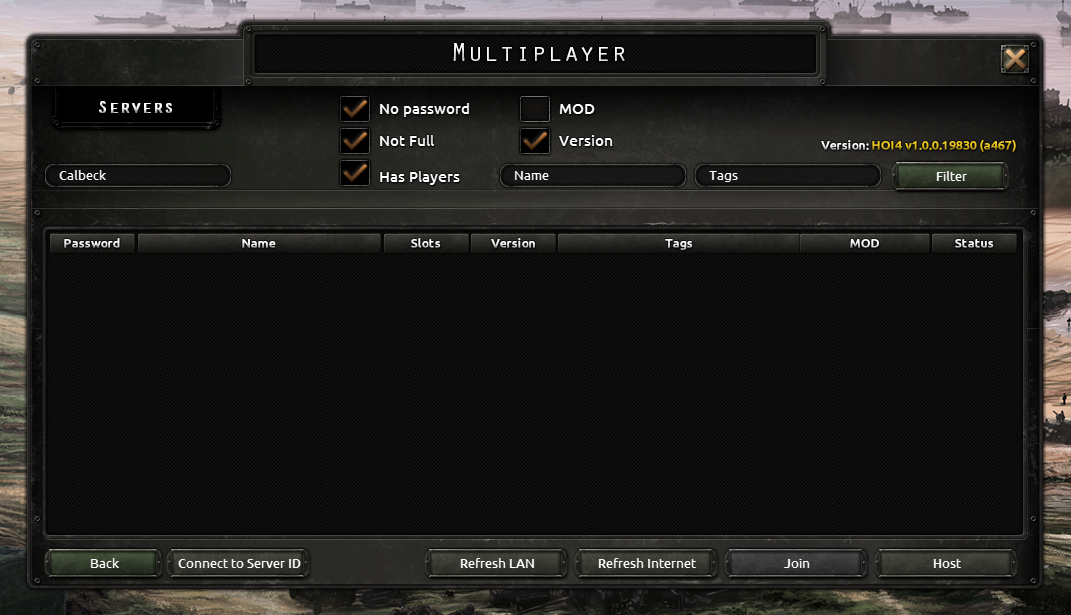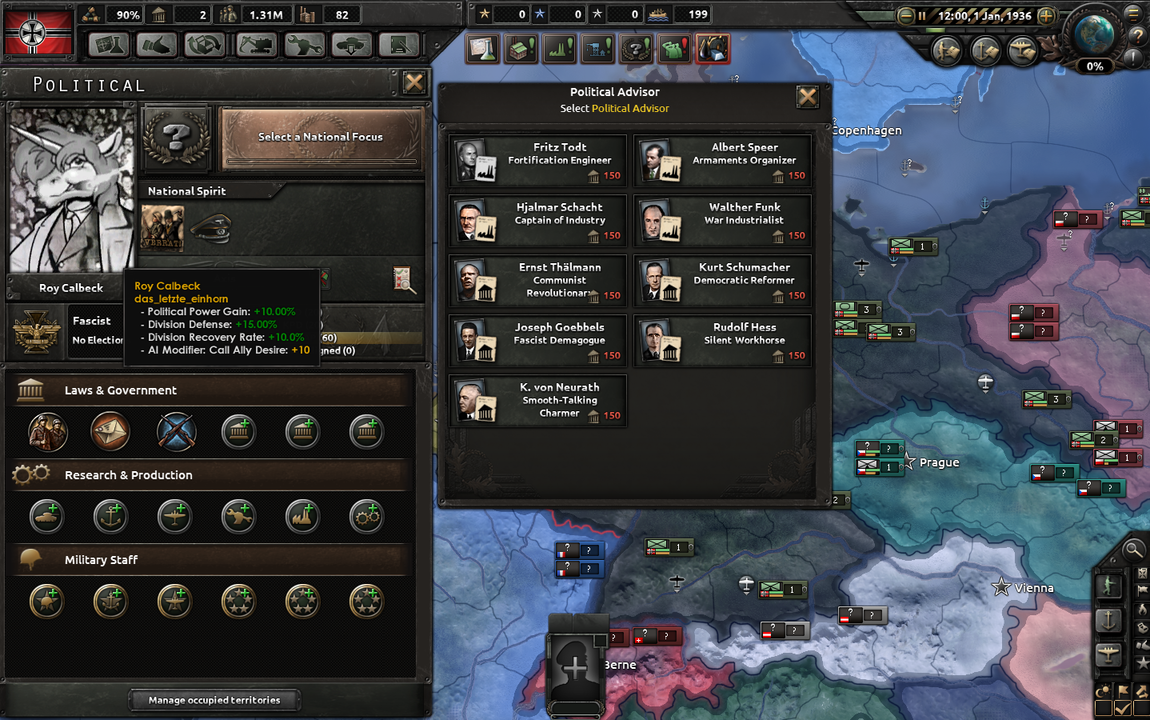Some believe that to understand the inner workings of warfare requires a heart of iron. That should one fail to do other than curse and shun its existence, one is somehow lauding the violence, death, and destruction inherent to its promulgation.
It cannot be ignored that, as with all wars, the Second World War's origins, progress, and aftermath all resulted from very human decisions. Each choice was influenced by the social, political, cultural and economic pressures of the time. Each was made in the belief that it was the best course available at that moment. And more than seventy years later, for both good and ill, those iron-hearted decisions continue to impact how our world is shaped.
With Hearts of Iron IV, Paradox Interactive asks the question: what would you have done differently?
That has always been the central draw for Hearts of Iron: player agency. You can turn Germany away from Fascism, slowly pressing it towards Democracy or even Communism. As Japan, you can attempt to build a future which doesn't involve attacking China or the United States. Heck, you can play as King Zog of Albania and see about giving Italy the two-fingered salute.
The drawback to such freedom of action has always been the attendant complexity involved and with it a steep learning curve. Rather than "dumb down" the internal clockwork for Hearts of Iron IV, Paradox has instead focused on helping players acclimate to it more readily.
One big change, in that department, is the introduction of a National Focus decision tree.
TREES, MEET FOREST: NATIONAL FOCUS

National Focus serves as a guiding beacon, letting you plan and carry out long-term strategies without having to fumble through quite so many details. Perhaps you'd like Germany to befriend its neighbors, rather than annex or invade them? That's entirely doable... even regarding Poland, the original flashpoint for Europe. Most nations have rather extensive decision trees tailored to their historical situations, as well as many "what-ifs". And if you want a game which locks the AI into the paths they historically took, there's an option for that too.
It's rare that a developer manages to provide even more options for gameplay while simultaneously simplifying things, but Paradox nails that combo here.
Nor are you required to use it, if you prefer to blaze your own wild and crazy path across mid-20th-Century Earth. You'll have to develop some extremely unique stratagems to land several of the Steam Achievements, such as "Duce Nuked'em" (Italy has to detonate a nuclear device in California to pull that one off). As good as it is, National Focus doesn't straitjacket your style.
IF YOU FAIL TO PLAN, PLAN TO FAIL
Nonetheless, Hearts of Iron remains one of those franchises where it's not quite enough to just Read The Freakin' Manual. The tutorial does cover the basic elements by putting you in command of Italy's Ethiopian adventure, and a wiki has been integrated into the game for contextual assistance, but the devil continues to inhabit the details. Take a look at that green highlight up there for "Anschluss". To trigger it, and thus annex Austria without a war, you'll have to re-militarize Germany's border with France and build up the Army. That's going to take 550,000 troops "in divisions in the field".
Okay... so how does one go about doing that?
Well, a Division is just a template that you plug Battalions into, as it's the Battalions which actually have troops in them. So, put ten Battalions into one Infantry Division, and that puts 10,000 troops in the field... right?

Not exactly.
As you can see here, the default German Infantry Division contains nine Infantry Battalions, plus one Support Battalion each of Artillery and Engineers, totaling 9600 troops. Well, 9000 troops, actually, as for some reason Support Battalions don't appear to count towards National Focus targets. Neither do the Air Force or Navy, which field no Divisions.
You're going to need a lot more soldiers if you're going to impress the Austrians!

Which means going into your Recruit & Deploy panel to queue up new forces.
Let's keep this example simple and go with thirty Infantry Divisions. A word of warning: unless you want the process to take forever and a day, do not just queue up thirty Divisions on a single order. Since each basic, unmodified German Infantry Division takes four months to equip, train and deploy, it would take ten years for that order to complete!
The solution? Multiple simultaneous assembly lines. Here I've set up six in parallel, each producing a string of five Divisions, which will meet the "Anschluss" requirement by mid-1937. But fielding that many Divisions, that quickly, is going to take a heavy toll on Germany's military manufacturing sector...

...which produces the actual equipment your units rely upon. Every bit of a soldier's kit, every aircraft, every ship, every tank, every artillery piece, all of it comes from a factory somewhere in your country. Here's where you allocate the industrial might necessary to make it happen.
Notice the slider on the right - because every entry has its own slot, you're going to end up with a rather long production list, even more so if you try your hand at vehicle variants. Oh yes, we'll get to that a bit later, but for now, it's enough to note that everything produced goes into a national stockpile, until a unit draws upon it for their initial kit, replacements or upgrades.
Getting back to those thirty Divisions: they draw Infantry and Support Equipment, as well as Towed Artillery. Divide the "per day" number by "total needed", and you'll see that while it takes four months to field a Division, it's just over three to produce their gear, so at least production will keep up with the training schedule. And yes, it's possible to rush Divisions through training once they have their kit if you're in that much of a hurry.
Whoof! All that, just to be able to meet ONE National Focus requirement... a tyrant's work is never done, is it?
YOU'VE GOT GUNS, WHAT ABOUT BUTTER?
Civilians need love, too! Or they start joining your political opposition... and that never ends well, does it?

Besides Military Factories, you also have Civilian Factories, which provide everything else a growing nation needs: domestic goods, trade goods, and buildings (including fortifications, radar stations, transport infrastructure, even more, factories, and so forth). The more peaceful your economy, the fewer Factories you'll be able to assign to national defense projects, but the easier it will be to build more Factories.

This dovetails straight into Trade policy. The closer to Free Trade you are, the better your rates are for Factory output, new construction, and technological development, but the more your raw resources are siphoned away to feed the global market.

Taken together, all of this amounts to a complex balancing act between national resources, industrial power, international trade and domestic policy - but again, Paradox has managed to all but eliminate the attendant micromanagement issues. Now, just do what you want, and if there's a problem making it happen, you'll be informed. Once underway, you may occasionally get a nag-alert if something goes wrong. Spend a couple of seconds fixing (or dismissing) the issue, and move on... no more having to keep an eagle-eye on the Resource Stockpiles!
Unless, of course, you're into that.
MILITARY EXPERIENCE: TRAINING TO WIN
As I mentioned, each type of Division (Infantry, Armor, Cavalry, etc. ) has a modifiable template, meaning you can add and remove different kinds of Battalions as you like.
Historically, for example, early British Army doctrine used slow-moving "infantry" tanks to reinforce its Infantry Divisions. In Hearts of Iron IV, that's as easy as adding a Battalion of Light Armor to the British Infantry Division template. You can also augment a Division's capabilities with a variety of Support elements, such as signal companies, engineers, and artillery batteries.

All of this is maintained by the template for that type of division, a standing set of orders known in the military profession as an "Order of Battle." Editing this template has the effect of ordering all divisions currently using it to match your changes - they will start drawing equipment, personnel, and supplies to make it happen. You can also create entirely new division templates from scratch, so as to leave existing Divisions alone or experiment with your own concepts.
None of this happens by magic, however. Military organizations rely heavily on teamwork and tactics. When you drop a brand-new Battalion into a Division, its commanders have to figure out how to most effectively employ it in any kind of foreseeable combat situation. To represent this "breaking in" process, each change you make costs Experience Points.
This is also true of any modifications you make to armored vehicles, ship, and aircraft. It can get very expensive to improve such attributes as armor, guns, engines, operational range, and mechanical reliability, particularly if you pile it all on at once! But then again, you might just need a bomber with that kind of range, or a tank with that kind of armor, or a sub with those sorts of torpedoes, to achieve your objectives.
There're several ways to obtain Experience: training, combat, individual National Focus events, and assigning particular military leaders to staff positions. Training and leadership take time, though. Want a lot of combat experience without formally going to war? Contribute expeditionary forces, or lend-lease war materiel, to someone else's conflict!
Yes, Hearts of Iron is still very complicated when you start looking under the hood. But Paradox has made exceptional strides towards just letting you jump in and drive, without removing your freedom of choice.
FULL FRONTAL DERPING
Alas, it's not all guns and roses.
One of the biggest issues Hearts of Iron has always faced is the sheer amount of micromanagement it takes to conduct a sizable war. To address this, Hearts of Iron IV introduces Battle Planning for frontal operations - you select an enemy's border, then use what amounts to a simplified "paint program" to draw instructions for your AI Generals directly on the map. Air and naval operations aren't even that complicated: create a task force or air wing, select their operating region and mission, and let 'em have at it.
Sounds easy, on the face of it... and for relatively small actions, especially when you have plenty of time to prepare beforehand, it seems to work just fine.

It's when you get into big, freewheeling dust-ups, like the Eastern Front or Pacific Theater, that things start getting out of hand.
See, once you've drawn up a battle plan, the forces you've assigned need to get into position and get ready... which can take upwards of a month. During which time, of course, your enemy is running around doing their own thing. By the time your plan can execute, it may be too late to bother with. Or worse, the AI could end up being utterly incapable of pulling it off.

This is what should be a simple, limited assault by the Chinese Army. Their objective is the capital of Japan's weaker ally, Mengkukuo. If China can knock them out of the war and gain a northern flanking position, a grand envelopment of the main Japanese Army becomes possible.
But after more than a month, having taken ONE province and with South Chahar apparently undefended to boot, most of the thirty-five divisions committed to this operation have wandered off to reinforce other parts of the line. In essence, my Field Marshal is ignoring my orders, handing Tojo the strategic initiative on a silver platter in doing so. Meanwhile, my other AI Field Marshal is doing just fine defending all of China's ports... because I haven't given him any leeway to do anything on his own whatsoever.
Now it could be that I simply haven't gotten a good enough grip on how the Battle Plan system operates. Maybe I'm missing something crucial, something which should be obvious. But in every one of my playthroughs so far, I've had to slow things down and take direct control to avoid "Electronic Football Syndrome".
CO-OP MODE: FRIENDSHIP IS WARFARE
While the AI is nonetheless challenging to play against, the real bragging rights in years to come will go to those who can defeat cunning, competent human opponents. Unfortunately, since this review is being written pre-launch and TechRaptor only has the one code, we could not check out the multiplayer aspects directly for ourselves.

There's also a setting under Options for "Cooperative" Mode, which "enables multiple players controlling one nation". Now that sounds intriguing - are they assigned as Field Marshals? Can they take over various government functions? Once the servers are up and running, I expect there'll be something of a stampede of gamers, all champing at the bit to get in the saddle and...
...wow, that's the fastest I've ever seen a mob form up. It looks like we'll have to wait a bit to find out!
Nice pitchforks, fellas!
NUDGE IT! MODDING HEARTS OF IRON
One other thing that's been a strength for the Hearts of Iron community is its passion for mods. Previously, one practically had to learn the game's code and programming parameters to put something together, but Paradox is making things easier with the immediate release of its "Nudge!" tool.
Yes, the exclamation point is part of its name.

Normally invisible, adding "-debug" to the game launcher's command line makes it pop up in the main menu. From there, if it has anything to do with the map - national borders, interior subdivisions, terrain, weather, supply lines, you name it, it can be messed with. That includes things like changing the size, position and facing of animated in-game units... which doesn't sound like it would be terribly useful until you realize Paradox has added support for the Clausewitz Maya Exporter. You can create and use your own custom 3D designs, as well as import units from other games based on the Clausewitz Engine!

That's some incredible flexibility. The keys to the game have been virtually handed over to its fans... one developer has said that whoever comes out with the first Battletech mod will "live forever in my heart."
More realistically, perhaps, it's only a matter of time until someone comes out with the Marx Brothers' nation of Fredonia, or Charlie Chaplin's Tomainia. And I can tell you myself; there's already been one mod in which a unicorn assassinates Hitler, Bormann, and Himmler to remake the German Reich in his image...

It's only going to get more interesting from here, folks.
Hearts of Iron IV was reviewed using a code provided by Paradox Interactive and was played on a Windows 7 PC via Steam.
Review Summary
Have a tip, or want to point out something we missed? Leave a Comment or e-mail us at tips@techraptor.net










